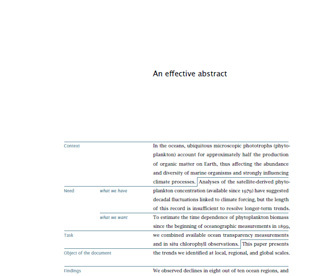The abstract
The readers of a scientific paper read the abstract for two purposes: to decide whether they want to (acquire and) read the full paper, and to prepare themselves for the details presented in that paper. An effective abstract helps readers achieve these two purposes. In particular, because it is typically read before the full paper, the abstract should present what the readers are primarily interested in; that is, what they want to know first of all and most of all.
Typically, readers are primarily interested in the information presented in a paper's
Introduction and
Conclusion sections. Primarily, they want to know the motivation for the work presented and the outcome of this work. Then (and only then) the most specialized among them might want to know the details of the work. Thus, an effective abstract focuses on motivation and outcome; in doing so, it parallels the paper's
Introduction and
Conclusion.
Accordingly, you can think of an abstract as having two distinct parts — motivation and outcome — even if it is typeset as a single paragraph. For the first part, follow the same structure as the
Introduction section of the paper: State the context, the need, the task, and the object of the document. For the second part, mention your findings (the
what) and, especially, your conclusion (the
so what — that is, the interpretation of your findings); if appropriate, end with perspectives, as in the
Conclusion section of your paper.
Although the structure of the abstract parallels the
Introduction and
Conclusion sections, it differs from these sections in the audience it addresses. The abstract is read by many different readers, from the most specialized to the least specialized among the target audience. In a sense, it should be the least specialized part of the paper. Any scientist reading it should be able to understand why the work was carried out and why it is important (context and need), what the authors did (task) and what the paper reports about this work (object of the document), what the authors found (findings), what these findings mean (the conclusion), and possibly what the next steps are (perspectives). In contrast, the full paper is typically read by specialists only; its
Introductionand
Conclusion are more detailed (that is, longer and more specialized) than the abstract.
An effective abstract stands on its own — it can be understood fully even when made available without the full paper. To this end, avoid referring to figures or the bibliography in the abstract. Also, introduce any acronyms the first time you use them in the abstract (if needed), and do so again in the full paper (see
Mechanics: Using abbreviations).


